18. Life in Industrial America
¶ 1
Leave a comment on paragraph 1 0
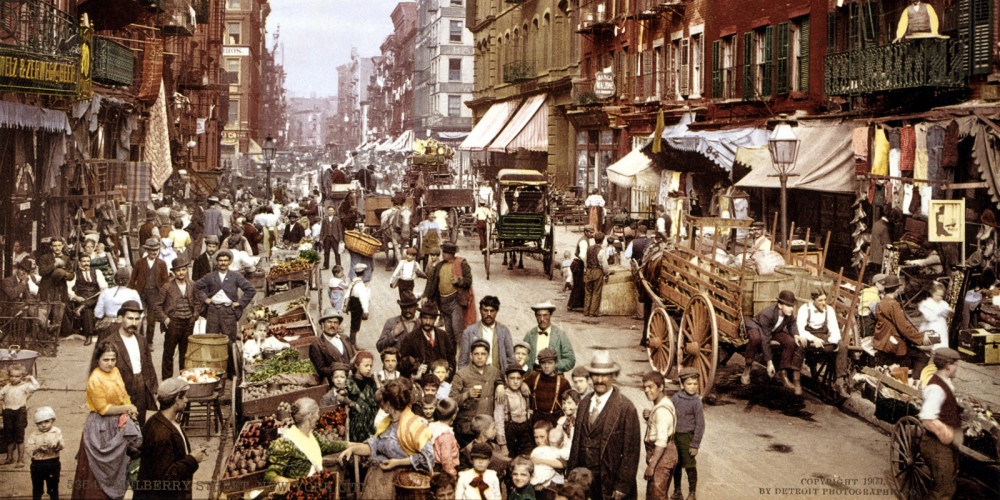 Mulberry Street, New York City, c. 1900, Library of Congress
Mulberry Street, New York City, c. 1900, Library of Congress
*The American Yawp is an evolving, collaborative text. Please click here to improve this chapter.*
I. Introduction
¶ 3 Leave a comment on paragraph 3 2 When British author Rudyard Kipling visited Chicago in 1889, he described a city captivated by technology and blinded by greed. He described a rushed and crowded city, a “huge wilderness” with “scores of miles of these terrible streets” and their “hundred thousand of these terrible people.” “The show impressed me with a great horror,” he wrote. “There was no color in the street and no beauty—only a maze of wire ropes overhead and dirty stone flagging under foot.” He took a cab “and the cabman said that these things were the proof of progress.” Kipling visited a “gilded and mirrored” hotel “crammed with people talking about money, and spitting about everywhere.” He visited extravagant churches and spoke with their congregants. “I listened to people who said that the mere fact of spiking down strips of iron to wood, and getting a steam and iron thing to run along them was progress, that the telephone was progress, and the network of wires overhead was progress. They repeated their statements again and again.” Kipling said American newspapers report “that the snarling together of telegraph-wires, the heaving up of houses, and the making of money is progress.” ((Rudyard Kipling, The Works of Rudyard Kipling, Volume II (New York: Doubleday, 1899), 141.))
¶ 4
Leave a comment on paragraph 4 0
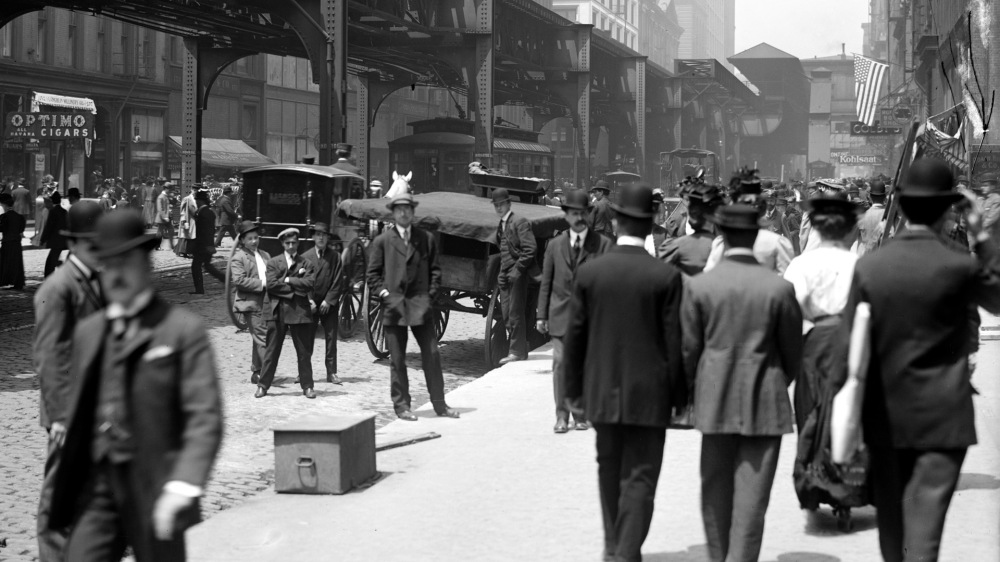 Wabash Avenue, Chicago, c. 1907. Library of Congress, LC-D4-70163.
Wabash Avenue, Chicago, c. 1907. Library of Congress, LC-D4-70163.
¶ 5 Leave a comment on paragraph 5 3 Chicago embodied the triumph of American industrialization. Its meatpacking industry typified the sweeping changes occurring in American life. The last decades of the nineteenth century, a new era for big business, saw the formation of large corporations, run by trained bureaucrats and salaried managers, doing national and international business. Chicago, for instance, became America’s butcher. The Chicago meat processing industry, a cartel of five firms, produced four fifths of the meat bought by American consumers. Kipling described in intimate detail the Union Stock Yards, the nation’s largest meat processing zone, a square mile just southwest of the city whose pens and slaughterhouses linked the city’s vast agricultural hinterland to the nation’s dinner tables. “Once having seen them,” he concluded, “you will never forget the sight.” Like other notable Chicago industries, such as agricultural machinery and steel production, the meatpacking industry was closely tied to urbanization and immigration. In 1850, Chicago had a population of about thirty thousand. Twenty years later, it had three hundred thousand. Nothing could stop the city’s growth. The Great Chicago Fire leveled 3.5 square miles and left a third of its residents homeless in 1871, but the city quickly recovered and resumed its spectacular growth. By the turn of the twentieth century, the city was home to 1.7 million people.
¶ 6 Leave a comment on paragraph 6 2 Chicago’s explosive growth reflected national trends. In 1870, a quarter of the nation’s population lived in towns or cities with populations greater than 2,500. By 1920, a majority did. But if many who flocked to Chicago and other American cities came from rural America, many others emigrated from overseas. Mirroring national immigration patterns, Chicago’s newcomers had at first come mostly from Germany, the British Isles, and Scandinavia, but, by 1890, Poles, Italians, Czechs, Hungarians, Lithuanians, and others from southern and eastern Europe made up a majority of new immigrants. Chicago, like many other American industrial cities, was also an immigrant city. In 1900, nearly 80 percent of Chicago’s population was either foreign-born or the children of foreign-born immigrants. ((For the transformation of Chicago, see William Cronon’s defining work, Nature’s Metropolis: Chicago and the West (New York: Norton, 1991).))
¶ 7 Leave a comment on paragraph 7 2 Kipling visited Chicago just as new industrial modes of production revolutionized the United States. The rise of cities, the evolution of American immigration, the transformation of American labor, the further making of a mass culture, the creation of great concentrated wealth, the growth of vast city slums, the conquest of the West, the emergence of a middle class, the problem of poverty, the triumph of big business, widening inequalities, battles between capital and labor, the final destruction of independent farming, breakthrough technologies, environmental destruction: industrialization created a new America.
¶ 8 Leave a comment on paragraph 8 0
II. Industrialization & Technological Innovation
¶ 9 Leave a comment on paragraph 9 2 The railroads created the first great concentrations of capital, spawned the first massive corporations, made the first of the vast fortunes that would define the Gilded Age, unleashed labor demands that united thousands of farmers and immigrants, and linked many towns and cities. National railroad mileage tripled in the twenty years after the outbreak of the Civil War, and tripled again over the four decades that followed. Railroads impelled the creation of uniform time zones across the country, gave industrialists access to remote markets, and opened the American West. Railroad companies were the nation’s largest businesses. Their vast national operations demanded the creation of innovative new corporate organization, advanced management techniques, and vast sums of capital. Their huge expenditures spurred countless industries and attracted droves of laborers. And as they crisscrossed the nation, they created a national market, a truly national economy, and, seemingly, a new national culture. ((See Richard White, Railroaded: The Transcontinentals and the Making of Modern America (New York: Norton, 2011).))
¶ 10 Leave a comment on paragraph 10 1 The railroads were not natural creations. Their vast capital requirements required the use of incorporation, a legal innovation that protected shareholders from losses. Enormous amounts of government support followed. Federal, state, and local governments offered unrivaled handouts to create the national rail networks. Lincoln’s Republican Party—which dominated government policy during the Civil War and Reconstruction—passed legislation granting vast subsidies. Hundreds of millions of acres of land and millions of dollars’ worth of government bonds were freely given to build the great transcontinental railroads and the innumerable trunk lines that quickly annihilated the vast geographic barriers that had so long sheltered American cities from one another.
¶ 11
Leave a comment on paragraph 11 0
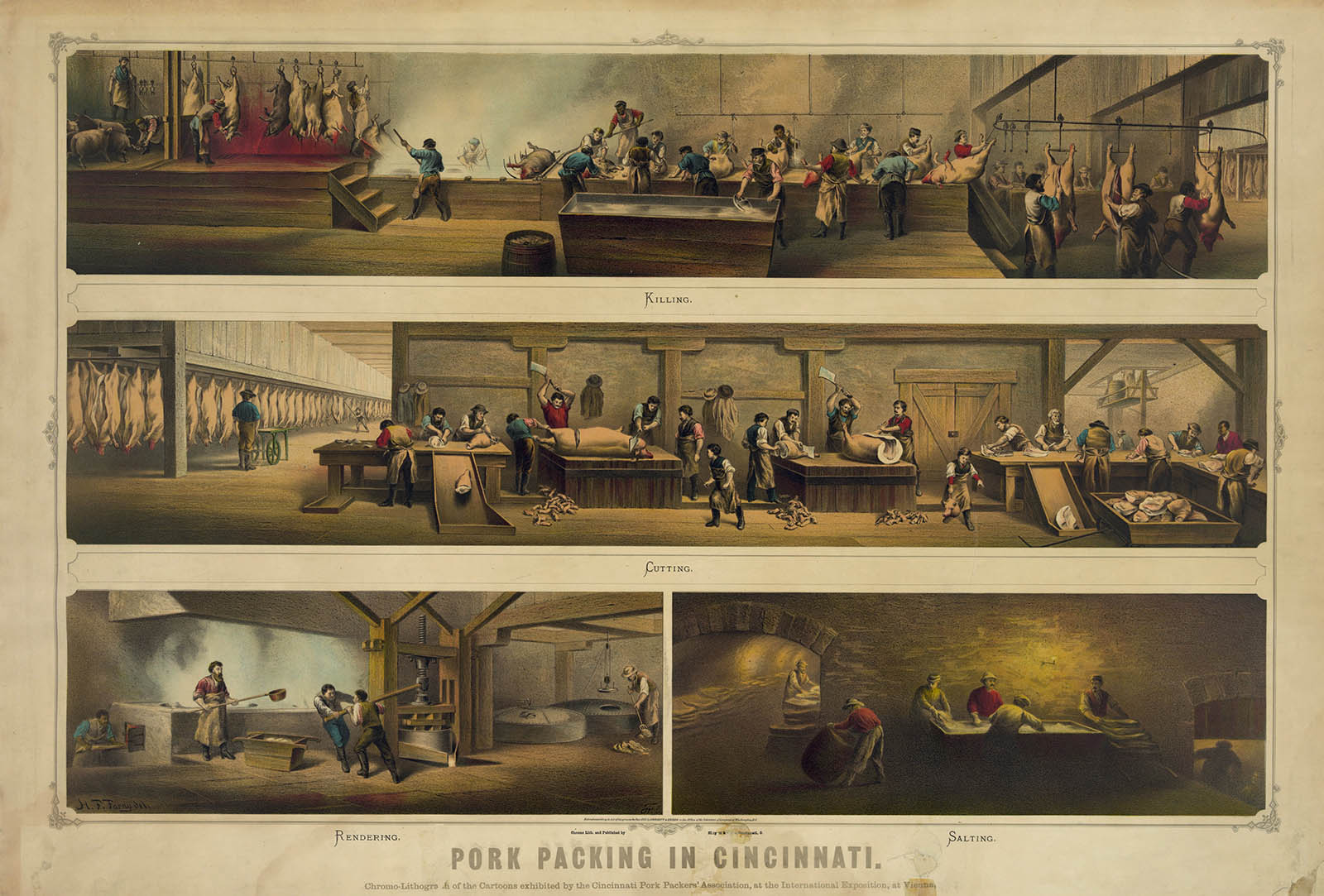 This print shows the four stages of pork packing in nineteenth-century Cincinnati. This centralization of production made meat-packing an innovative industry, one of great interest to industrialists of all ilks. In fact, this chromo-lithograph was exhibited by the Cincinnati Pork Packers’ Association at the International Exposition in Vienna, Austria. 1873. Wikimedia.
This print shows the four stages of pork packing in nineteenth-century Cincinnati. This centralization of production made meat-packing an innovative industry, one of great interest to industrialists of all ilks. In fact, this chromo-lithograph was exhibited by the Cincinnati Pork Packers’ Association at the International Exposition in Vienna, Austria. 1873. Wikimedia.
¶ 12 Leave a comment on paragraph 12 1 As railroad construction drove economic development, new means of production spawned new systems of labor. Many wage earners had traditionally seen factory work as a temporary stepping-stone to attaining their own small businesses or farms. After the war, however, new technology and greater mechanization meant fewer and fewer workers could legitimately aspire to economic independence. Stronger and more organized labor unions formed to fight for a growing, more-permanent working class. At the same time, the growing scale of economic enterprises increasingly disconnected owners from their employees and day-to-day business operations. To handle their vast new operations, owners turned to managers. Educated bureaucrats swelled the ranks of an emerging middle class.
¶ 13 Leave a comment on paragraph 13 1 Industrialization also remade much of American life outside the workplace. Rapidly growing industrialized cities knit together urban consumers and rural producers into a single, integrated national market. Food production and consumption, for instance, were utterly nationalized. Chicago’s stockyards seemingly tied it all together. Between 1866 and 1886, ranchers drove a million head of cattle annually overland from Texas ranches to railroad depots in Kansas for shipment by rail to Chicago. After travelling through modern “disassembly lines,” the animals left the adjoining slaughterhouses as slabs of meat to be packed into refrigerated rail cars and sent to butcher shops across the continent. By 1885, a handful of large-scale industrial meatpackers in Chicago were producing nearly five hundred million pounds of “dressed” beef annually. ((Cronon, Nature’s Metropolis, 239.)) The new scale of industrialized meat production transformed the landscape. Buffalo herds, grasslands, and old-growth forests gave way to cattle, corn, and wheat. Chicago became the Gateway City, a crossroads connecting American agricultural goods, capital markets in New York and London, and consumers from all corners of the United States.
¶ 14 Leave a comment on paragraph 14 2 Technological innovation accompanied economic development. For April Fool’s Day in 1878, the New York Daily Graphic published a fictitious interview with the celebrated inventor Thomas A. Edison. The piece described the “biggest invention of the age”—a new Edison machine that could create forty different kinds of food and drink out of only air, water, and dirt. “Meat will no longer be killed and vegetables no longer grown, except by savages,” Edison promised. The machine would end “famine and pauperism.” And all for $5 or $6 per machine! The story was a joke, of course, but Edison nevertheless received inquiries from readers wondering when the food machine would be ready for the market. Americans had apparently witnessed such startling technological advances—advances that would have seemed far-fetched mere years earlier—that the Edison food machine seemed entirely plausible. ((David Hochfelder, “Edison and the Age of Invention,” in A Companion to the Reconstruction Presidents 1865–1881, ed. Edward O. Frantz (Chichester, UK: Blackwell, 2014), 499.))
¶ 15 Leave a comment on paragraph 15 2 In September 1878, Edison announced a new and ambitious line of research and development—electric power and lighting. The scientific principles behind dynamos and electric motors—the conversion of mechanical energy to electrical power, and vice versa—were long known, but Edison applied the age’s bureaucratic and commercial ethos to the problem. Far from a lone inventor gripped by inspiration toiling in isolation, Edison advanced the model of commercially minded management of research and development. Edison folded his two identities, business manager and inventor, together. He called his Menlo Park research laboratory an “invention factory” and promised to turn out “a minor invention every ten days and a big thing every six months or so.” He brought his fully equipped Menlo Park research laboratory and the skilled machinists and scientists he employed to bear on the problem of building an electric power system—and commercializing it.
¶ 16 Leave a comment on paragraph 16 2 By late fall 1879, Edison exhibited his system of power generation and electrical light for reporters and investors. Then he scaled up production. He sold generators to businesses. By the middle of 1883, Edison had overseen construction of 330 plants powering over sixty thousand lamps in factories, offices, printing houses, hotels, and theaters around the world. He convinced municipal officials to build central power stations and run power lines. New York’s Pearl Street central station opened in September 1882 and powered a square mile of downtown Manhattan. Electricity revolutionized the world. It not only illuminated the night, it powered the Second Industrial Revolution. Factories could operate anywhere at any hour. Electric rail cars allowed for cities to build out and electric elevators allowed for them to build up.
¶ 17 Leave a comment on paragraph 17 1 Economic advances, technological innovation, social and cultural evolution, demographic changes: the United States was a nation transformed. Industry boosted productivity, railroads connected the nation, more and more Americans labored for wages, new bureaucratic occupations created a vast “white collar” middle class, and unprecedented fortunes rewarded the owners of capital. These revolutionary changes, of course, would not occur without conflict or consequence (see Chapter 16), but they demonstrated the profound transformations remaking the nation. Change was not confined to economics alone. Change gripped the lives of everyday Americans and fundamentally reshaped American culture. ((Ibid., 499–517.))
¶ 18 Leave a comment on paragraph 18 0
III. Immigration and Urbanization
¶ 19
Leave a comment on paragraph 19 0
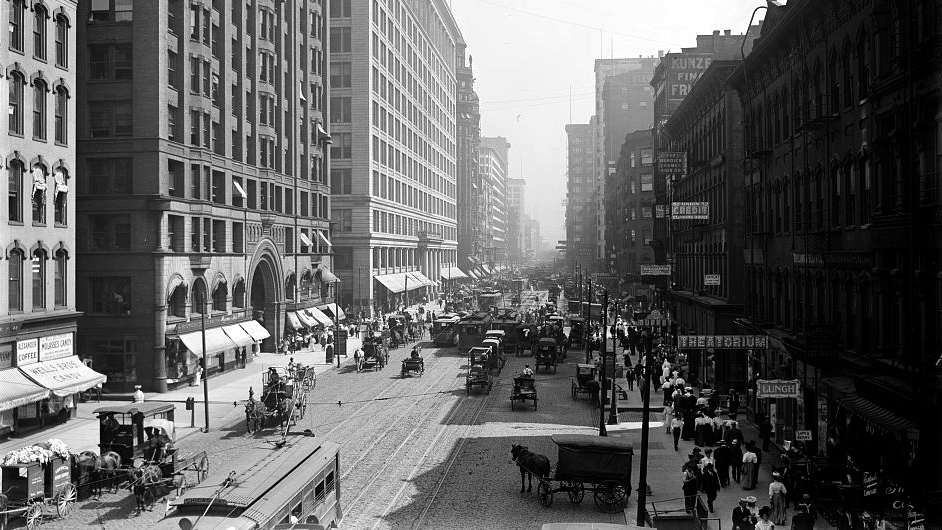 State Street, south from Lake Street, Chicago, Ill, ca.1900-1910. Library of Congress, LC-D4-70158.
State Street, south from Lake Street, Chicago, Ill, ca.1900-1910. Library of Congress, LC-D4-70158.
¶ 20 Leave a comment on paragraph 20 1 Industry pulled ever more Americans into cities. Manufacturing needed the labor pool and the infrastructure. America’s urban population increased sevenfold in the half century after the Civil War. Soon the United States had more large cities than any country in the world. The 1920 U.S. census revealed that, for the first time, a majority of Americans lived in urban areas. Much of that urban growth came from the millions of immigrants pouring into the nation. Between 1870 and 1920, over twenty-five million immigrants arrived in the United States.
¶ 21 Leave a comment on paragraph 21 3 By the turn of the twentieth century, new immigrant groups such as Italians, Poles, and Eastern European Jews made up a larger percentage of arrivals than the Irish and Germans. The specific reasons that immigrants left their particular countries and the reasons they came to the United States (what historians call push and pull factors) varied. For example, a young husband and wife living in Sweden in the 1880s and unable to purchase farmland might read an advertisement for inexpensive land in the American Midwest and immigrate to the United States to begin a new life. A young Italian man might simply hope to labor in a steel factory long enough to save up enough money to return home and purchase land for a family. A Russian Jewish family persecuted in European pogroms might look to the United States as a sanctuary. Or perhaps a Japanese migrant might hear of fertile farming land on the West Coast and choose to sail for California. But if many factors pushed people away from their home countries, by far the most important factor drawing immigrants was economics. Immigrants came to the United States looking for work.
¶ 22 Leave a comment on paragraph 22 2 Industrial capitalism was the most important factor that drew immigrants to the United States between 1880 and 1920. Immigrant workers labored in large industrial complexes producing goods such as steel, textiles, and food products, replacing smaller and more local workshops. The influx of immigrants, alongside a large movement of Americans from the countryside to the city, helped propel the rapid growth of cities like New York, Pittsburgh, Cleveland, Milwaukee, and St. Louis. By 1890, immigrants and their children accounted for roughly 60 percent of the population in most large northern cities (and sometimes as high as 80 or 90 percent). Many immigrants, especially from Italy and the Balkans, always intended to return home with enough money to purchase land. But what about those who stayed? Did the new arrivals assimilate together in the American melting pot—becoming just like those already in the United States—or did they retain, and sometimes even strengthen, their traditional ethnic identities? The answer lies somewhere in between. Immigrants from specific countries—and often even specific communities—often clustered together in ethnic neighborhoods. They formed vibrant organizations and societies, such as Italian workmen’s clubs, Eastern European Jewish mutual aid societies, and Polish Catholic churches, to ease the transition to their new American home. Immigrant communities published newspapers in dozens of languages and purchased spaces to maintain their arts, languages, and traditions alive. And from these foundations they facilitated even more immigration: after staking out a claim to some corner of American life, they wrote home and encouraged others to follow them (historians call this chain migration).
¶ 23 Leave a comment on paragraph 23 2 Many cities’ politics adapted to immigrant populations. The infamous urban political machines often operated as a kind of mutual aid society. New York City’s Democratic Party machine, popularly known as Tammany Hall, drew the greatest ire from critics and seemed to embody all of the worst of city machines, but it also responded to immigrant needs. In 1903, journalist William Riordon published a book, Plunkitt of Tammany Hall, which chronicled the activities of ward heeler George Washington Plunkitt. Plunkitt elaborately explained to Riordon the difference between “honest graft” and “dishonest graft”: “I made my pile in politics, but, at the same time, I served the organization and got more big improvements for New York City than any other livin’ man.” While exposing corruption, Riordon also revealed the hard work Plunkitt undertook on behalf of his largely immigrant constituency. On a typical day, Riordon wrote, Plunkitt was awakened at two a.m. to bail out a saloonkeeper who stayed open too late, was awakened again at six a.m. because of a fire in the neighborhood and spent time finding lodgings for the families displaced by the fire, and, after spending the rest of the morning in court to secure the release of several of his constituents, found jobs for four unemployed men, attended an Italian funeral, visited a church social, and dropped in on a Jewish wedding. He returned home at midnight. ((William L. Riordon, Plunkitt of Tammany Hall: A Series of Very Plain Talks on Very Practical Politics (New York: McClure, Phillips, 1905).))
¶ 24 Leave a comment on paragraph 24 0 Tammany Hall’s corruption, especially under the reign of William “Boss” Tweed, was legendary, but the public works projects that funded Tammany Hall’s graft also provided essential infrastructure and public services for the city’s rapidly expanding population. Water, sewer, and gas lines; schools, hospitals, civic buildings, and museums; police and fire departments; roads, parks (notably Central Park), and bridges (notably the Brooklyn Bridge): all could, in whole or in part, be credited to Tammany’s reign. Still, machine politics could never be enough. As the urban population exploded, many immigrants found themselves trapped in crowded, crime-ridden slums. Americans eventually took notice of this urban crisis and proposed municipal reforms but also grew concerned about the declining quality of life in rural areas.
¶ 25 Leave a comment on paragraph 25 0 While cities boomed, rural worlds languished. Some Americans scoffed at rural backwardness and reveled in the countryside’s decay, but many romanticized the countryside, celebrated rural life, and wondered what had been lost in the cities. Sociologist Kenyon Butterfield, concerned by the sprawling nature of industrial cities and suburbs, regretted the eroding social position of rural citizens and farmers: “Agriculture does not hold the same relative rank among our industries that it did in former years.” Butterfield saw “the farm problem” as part of “the whole question of democratic civilization.” ((Kenyon L. Butterfield, Chapters in Rural Progress (Chicago: University of Chicago Press, 1908), 15.)) He and many others thought the rise of the cities and the fall of the countryside threatened traditional American values. Many proposed conservation. Liberty Hyde Bailey, a botanist and rural scholar selected by Theodore Roosevelt to chair a federal Commission on Country Life in 1907, believed that rural places and industrial cities were linked: “Every agricultural question is a city question.” ((L. H. Bailey, The Harvest of the Year to the Tiller of the Soil (New York: Macmillan, 1927), 60.))
¶ 26 Leave a comment on paragraph 26 1 Many longed for a middle path between the cities and the country. New suburban communities on the outskirts of American cities defined themselves in opposition to urban crowding. Americans contemplated the complicated relationships between rural places, suburban living, and urban spaces. Los Angeles became a model for the suburban development of rural places. Dana Barlett, a social reformer in Los Angeles, noted that the city, stretching across dozens of small towns, was “a better city” because of its residential identity as a “city of homes.” ((Oscar Osburn Winther, “The Rise of Metropolitan Los Angeles, 1870–1900,” Huntington Library Quarterly 10 (August 1947), 391-405.)) This language was seized upon by many suburbs that hoped to avoid both urban sprawl and rural decay. In Glendora, one of these small towns on the outskirts of Los Angeles, local leaders were “loath as anyone to see it become cosmopolitan.” Instead, in order to have Glendora “grow along the lines necessary to have it remain an enjoyable city of homes,” they needed to “bestir ourselves to direct its growth” by encouraging not industry or agriculture but residential development. ((“Chamber Meeting,” Glendora Gleaner, September 28, 1923.))
¶ 27 Leave a comment on paragraph 27 0
IV. The New South and the Problem of Race
¶ 28 Leave a comment on paragraph 28 0 “There was a South of slavery and secession,” Atlanta Constitution editor Henry Grady proclaimed in an 1886 speech in New York. “That South is dead.” ((Henry Grady, The Complete Orations and Speeches of Henry Grady, ed. Edwin DuBois Shurter (New York: Hinds, Noble and Eldredge, 1910), 7.)) Grady captured the sentiment of many white southern business and political leaders who imagined a New South that could turn its back to the past by embracing industrialization and diversified agriculture. He promoted the region’s economic possibilities and mutual future prosperity through an alliance of northern capital and southern labor. Grady and other New South boosters hoped to shape the region’s economy in the North’s image. They wanted industry and they wanted infrastructure. But the past could not be escaped. Economically and socially, the “New South” would still be much like the old.
¶ 29
Leave a comment on paragraph 29 0
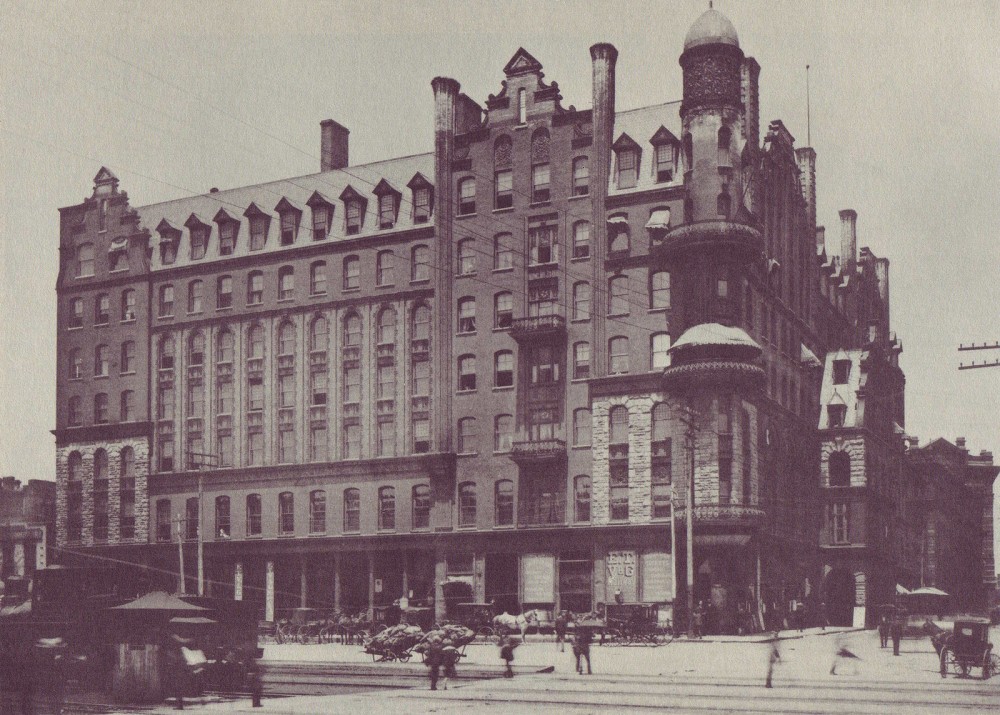 The ambitions of Atlanta, seen in the construction of such grand buildings as the Kimball House Hotel, reflected the larger regional aspirations of the so-called New South. 1890. Wikimedia.
The ambitions of Atlanta, seen in the construction of such grand buildings as the Kimball House Hotel, reflected the larger regional aspirations of the so-called New South. 1890. Wikimedia.
¶ 30 Leave a comment on paragraph 30 1 A “New South” seemed an obvious need. The Confederacy’s failed insurrection wreaked havoc on the southern economy and crippled southern prestige. Property was destroyed. Lives were lost. Political power vanished. And four million enslaved Americans—representing the wealth and power of the antebellum white South—threw off their chains and walked proudly forward into freedom.
¶ 31 Leave a comment on paragraph 31 0 Emancipation unsettled the southern social order. When Reconstruction regimes attempted to grant freedpeople full citizenship rights, anxious whites struck back. From their fear, anger, and resentment they lashed out, not only in organized terrorist organizations such as the Ku Klux Klan but in political corruption, economic exploitation, and violent intimidation. White southerners took back control of state and local governments and used their reclaimed power to disenfranchise African Americans and pass “Jim Crow” laws segregating schools, transportation, employment, and various public and private facilities. The reestablishment of white supremacy after the “redemption” of the South from Reconstruction contradicted proclamations of a “New” South. Perhaps nothing harked so forcefully back to the barbaric southern past than the wave of lynchings—the extralegal murder of individuals by vigilantes—that washed across the South after Reconstruction. Whether for actual crimes or fabricated crimes or for no crimes at all, white mobs murdered roughly five thousand African Americans between the 1880s and the 1950s.
¶ 32 Leave a comment on paragraph 32 3 Lynching was not just murder, it was a ritual rich with symbolism. Victims were not simply hanged, they were mutilated, burned alive, and shot. Lynchings could become carnivals, public spectacles attended by thousands of eager spectators. Rail lines ran special cars to accommodate the rush of participants. Vendors sold goods and keepsakes. Perpetrators posed for photos and collected mementos. And it was increasingly common. One notorious example occurred in Georgia in 1899. Accused of killing his white employer and raping the man’s wife, Sam Hose was captured by a mob and taken to the town of Newnan. Word of the impending lynching quickly spread, and specially chartered passenger trains brought some four thousand visitors from Atlanta to witness the gruesome affair. Members of the mob tortured Hose for about an hour. They sliced off pieces of his body as he screamed in agony. Then they poured a can of kerosene over his body and burned him alive. ((William Fitzhugh Brundage, Lynching in the New South: Georgia and Virginia, 1880–1930 (Champaign: University of Illinois Press, 1993), 82–84.))
¶ 33 Leave a comment on paragraph 33 0 At the barbaric height of southern lynching, in the last years of the nineteenth century, southerners lynched two to three African Americans every week. In general, lynchings were most frequent in the Cotton Belt of the Lower South, where southern blacks were most numerous and where the majority worked as tenant farmers and field hands on the cotton farms of white landowners. The states of Mississippi and Georgia had the greatest number of recorded lynchings: from 1880 to 1930, Mississippi lynch mobs killed over five hundred African Americans; Georgia mobs murdered more than four hundred.
¶ 34 Leave a comment on paragraph 34 1 Throughout the late nineteenth and early twentieth centuries, a number of prominent southerners openly supported lynching, arguing that it was a necessary evil to punish black rapists and deter others. In the late 1890s, Georgia newspaper columnist and noted women’s rights activist Rebecca Latimer Felton—who would later become the first woman to serve in the U.S. Senate—endorsed such extrajudicial killings. She said, “If it takes lynching to protect women’s dearest possession from drunken, ravening beasts, then I say lynch a thousand a week.” ((Grace Elizabeth Hale, Making Whiteness: The Culture of Segregation in the South, 1890–1940 (New York: Pantheon Books, 1998), 201.)) When opponents argued that lynching violated victims’ constitutional rights, South Carolina governor Coleman Blease angrily responded, “Whenever the Constitution comes between me and the virtue of the white women of South Carolina, I say to hell with the Constitution.” ((Jacquelyn Dowd Hall, Revolt Against Chivalry: Jessie Daniel Ames and the Women’s Campaign Against Lynching (New York: Columbia University Press, 1993), 195.))
¶ 35
Leave a comment on paragraph 35 0
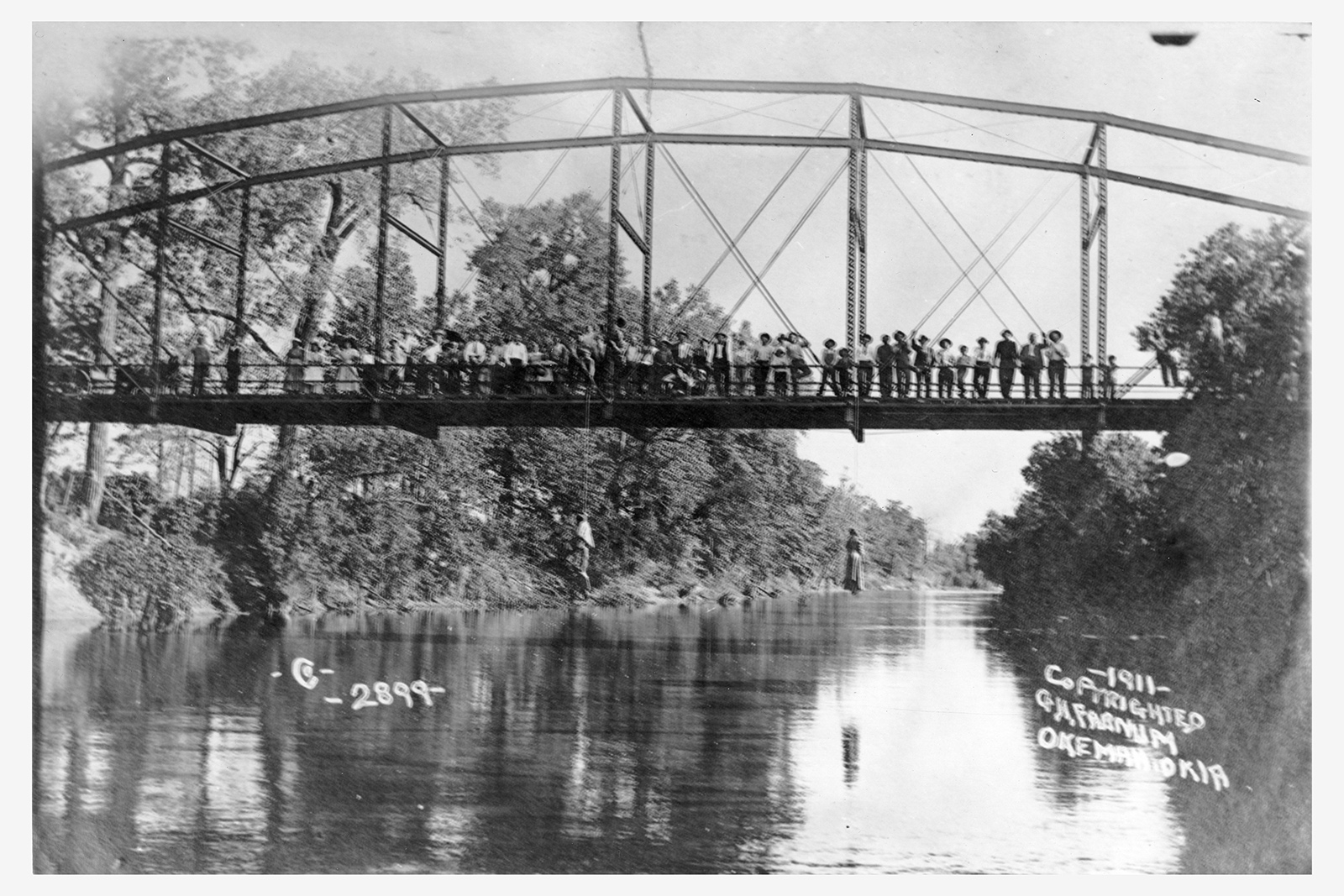 This photograph captures the lynching of Laura and Lawrence Nelson, a mother and son, on May 25, 1911, in Okemah, Oklahoma. In response to national attention, the local white newspaper in Okemah simply wrote, “While the general sentiment is adverse to the method, it is generally thought that the negroes got what would have been due them under due process of law.” Wikimedia.
This photograph captures the lynching of Laura and Lawrence Nelson, a mother and son, on May 25, 1911, in Okemah, Oklahoma. In response to national attention, the local white newspaper in Okemah simply wrote, “While the general sentiment is adverse to the method, it is generally thought that the negroes got what would have been due them under due process of law.” Wikimedia.
¶ 36 Leave a comment on paragraph 36 0 Black activists and white allies worked to outlaw lynching. Ida B. Wells, an African American woman born in the last years of slavery and a pioneering anti-lynching advocate, lost three friends to a lynch mob in Memphis, Tennessee, in 1892. That year, Wells published Southern Horrors: Lynch Law in All Its Phases, a groundbreaking work that documented the South’s lynching culture and exposed the myth of the black rapist. ((Ida B. Wells, Crusade for Justice: The Autobiography of Ida B. Wells (Chicago: University of Chicago Press, 1970).)) The Tuskegee Institute and the NAACP both compiled and publicized lists of every reported lynching in the United States. In 1918, Representative Leonidas Dyer of Missouri introduced federal anti-lynching legislation that would have made local counties where lynchings took place legally liable for such killings. Throughout the early 1920s, the Dyer Bill was the subject of heated political debate, but, fiercely opposed by southern congressmen and unable to win enough northern champions, the proposed bill was never enacted.
¶ 37 Leave a comment on paragraph 37 1 Lynching was only the violent worst of the southern racial world. Discrimination in employment and housing and the legal segregation of public and private life reflected the rise of a new Jim Crow South. So-called Jim Crow laws legalized what custom had long dictated. Southern states and municipalities enforced racial segregation in public places and in private lives. Separate coach laws were some of the first such laws to appear, beginning in Tennessee in the 1880s. Soon schools, stores, theaters, restaurants, bathrooms, and nearly every other part of public life were segregated. So too were social lives. The sin of racial mixing, critics said, had to be heavily guarded against. Marriage laws regulated against interracial couples, and white men, ever anxious of relationships between black men and white women, passed miscegenation laws and justified lynching as an appropriate extralegal tool to police the racial divide.
¶ 38 Leave a comment on paragraph 38 2 In politics, de facto limitations of black voting had suppressed black voters since Reconstruction. Whites stuffed ballot boxes and intimidated black voters with physical and economic threats. And then, from roughly 1890 to 1908, southern states implemented de jure, or legal, disfranchisement. They passed laws requiring voters to pass literacy tests (which could be judged arbitrarily) and pay poll taxes (which hit poor whites and poor blacks alike), effectively denying black men the franchise that was supposed to have been guaranteed by the Fifteenth Amendment. Those responsible for such laws posed as reformers and justified voting restrictions as for the public good, a way to clean up politics by purging corrupt African Americans from the voting rolls.
¶ 39 Leave a comment on paragraph 39 1 With white supremacy secured, prominent white southerners looked outward for support. New South boosters hoped to confront post-Reconstruction uncertainties by rebuilding the South’s economy and convincing the nation that the South could be more than an economically backward, race-obsessed backwater. And as they did, they began to retell the history of the recent past. A kind of civic religion known as the “Lost Cause” glorified the Confederacy and romanticized the Old South. White southerners looked forward while simultaneously harking back to an imagined past inhabited by contented and loyal slaves, benevolent and generous masters, chivalric and honorable men, and pure and faithful southern belles. Secession, they said, had little to do with the institution of slavery, and soldiers fought only for home and honor, not the continued ownership of human beings. The New South, then, would be built physically with new technologies, new investments, and new industries, but undergirded by political and social custom.
¶ 40 Leave a comment on paragraph 40 2 Henry Grady might have declared the Confederate South dead, but its memory pervaded the thoughts and actions of white southerners. Lost Cause champions overtook the South. Women’s groups, such as the United Daughters of the Confederacy, joined with Confederate veterans to preserve a pro-Confederate past. They built Confederate monuments and celebrated Confederate veterans on Memorial Day. Across the South, towns erected statues of General Robert E. Lee and other Confederate figures. By the turn of the twentieth century, the idealized Lost Cause past was entrenched not only in the South but across the country. In 1905, for instance, North Carolinian Thomas F. Dixon published a novel, The Clansman, which depicted the Ku Klux Klan as heroic defenders of the South against the corruption of African American and northern “carpetbag” misrule during Reconstruction. In 1915, acclaimed film director David W. Griffith adapted Dixon’s novel into the groundbreaking blockbuster film, Birth of a Nation. (The film almost singlehandedly rejuvenated the Ku Klux Klan.) The romanticized version of the antebellum South and the distorted version of Reconstruction dominated popular imagination. ((Charles Reagan Wilson, Baptized in Blood: The Religion of the Lost Cause, 1865–1920 (Athens: University of Georgia Press, 1980).))
¶ 41 Leave a comment on paragraph 41 1 While Lost Cause defenders mythologized their past, New South boosters struggled to wrench the South into the modern world. The railroads became their focus. The region had lagged behind the North in the railroad building boom of the midnineteenth century, and postwar expansion facilitated connections between the most rural segments of the population and the region’s rising urban areas. Boosters campaigned for the construction of new hard-surfaced roads as well, arguing that improved roads would further increase the flow of goods and people and entice northern businesses to relocate to the region. The rising popularity of the automobile after the turn of the century only increased pressure for the construction of reliable roads between cities, towns, county seats, and the vast farmlands of the South.
¶ 42 Leave a comment on paragraph 42 1 Along with new transportation networks, New South boosters continued to promote industrial growth. The region witnessed the rise of various manufacturing industries, predominantly textiles, tobacco, furniture, and steel. While agriculture—cotton in particular—remained the mainstay of the region’s economy, these new industries provided new wealth for owners, new investments for the region, and new opportunities for the exploding number of landless farmers to finally flee the land. Industries offered low-paying jobs but also opportunity for rural poor who could no longer sustain themselves through subsistence farming. Men, women, and children all moved into wage work. At the turn of the twentieth century, nearly one fourth of southern mill workers were children aged six to sixteen.
¶ 43 Leave a comment on paragraph 43 0 In most cases, as in most aspects of life in the New South, new factory jobs were racially segregated. Better-paying jobs were reserved for whites, while the most dangerous, labor-intensive, dirtiest, and lowest-paying positions were relegated to African Americans. African American women, shut out of most industries, found employment most often as domestic help for white families. As poor as white southern mill workers were, southern blacks were poorer. Some white mill workers could even afford to pay for domestic help in caring for young children, cleaning houses, doing laundry, and cooking meals. Mill villages that grew up alongside factories were whites-only, and African American families were pushed to the outer perimeter of the settlements.
¶ 44 Leave a comment on paragraph 44 3 That a “New South” emerged in the decades between Reconstruction and World War I is debatable. If measured by industrial output and railroad construction, the New South was a reality but if measured relative to the rest of the nation, it was a limited one. If measured in terms of racial discrimination, however, the New South looked much like the Old. Boosters such as Henry Grady said the South was done with racial questions but lynching and segregation and the institutionalization of Jim Crow exposed the South’s lingering racial obsessions. Meanwhile, most southerners still toiled in agriculture and still lived in poverty. Industrial development and expanding infrastructure, rather than re-creating the South, coexisted easily with white supremacy and an impoverished agricultural economy. The trains came, factories were built, and capital was invested, but the region remained mired in poverty and racial apartheid. Much of the “New South,” then, was anything but new.
¶ 45 Leave a comment on paragraph 45 0
V. Gender, Religion, and Culture
¶ 46
Leave a comment on paragraph 46 0
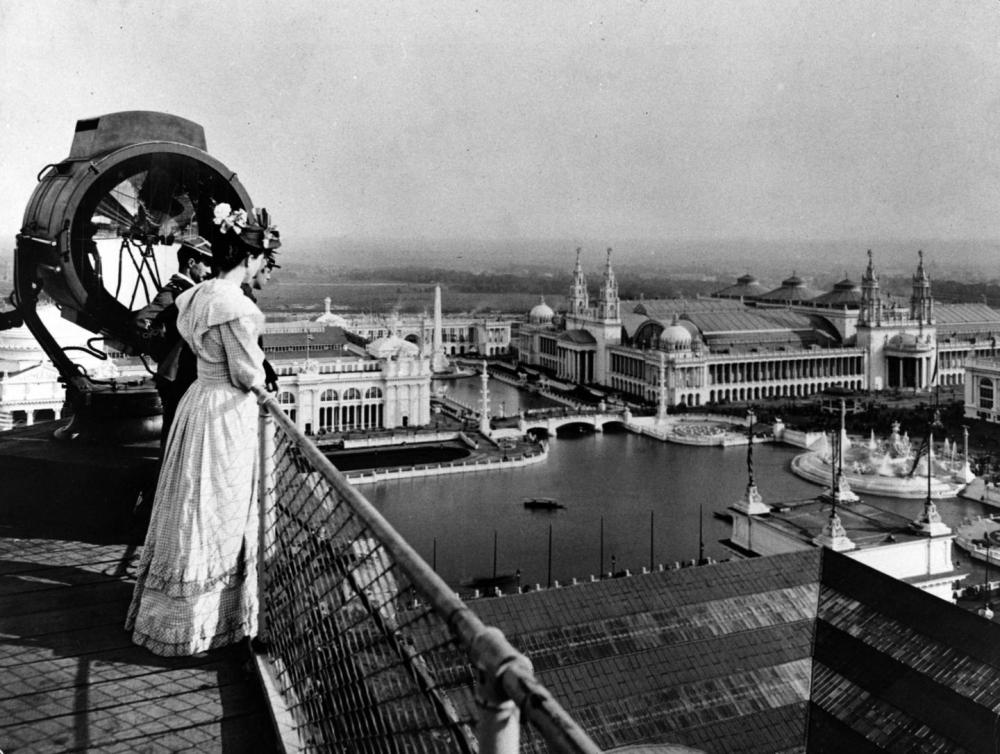 Visitors to the Columbian Exposition of 1893 took in the view of the Court of Honor from the roof of the Manufacturers Building. Art Institute of Chicago, via Wikimedia
Visitors to the Columbian Exposition of 1893 took in the view of the Court of Honor from the roof of the Manufacturers Building. Art Institute of Chicago, via Wikimedia
¶ 47 Leave a comment on paragraph 47 2 In 1905, Standard Oil tycoon John D. Rockefeller donated $100,000 (about $2.5 million today) to the American Board of Commissioners for Foreign Missions. Rockefeller was the richest man in America but also one of the most hated and mistrusted. Even admirers conceded that he achieved his wealth through often illegal and usually immoral business practices. Journalist Ida Tarbell had made waves describing Standard Oil’s long-standing ruthlessness and predilections for political corruption. Clergymen, led by reformer Washington Gladden, fiercely protested the donation. A decade earlier, Gladden had asked of such donations, “Is this clean money? Can any man, can any institution, knowing its origin, touch it without being defiled?” Gladden said, “In the cool brutality with which properties are wrecked, securities destroyed, and people by the hundreds robbed of their little all to build up the fortunes of the multi-millionaires, we have an appalling revelation of the kind of monster that a human being may become.” ((Washington Gladden, The New Idolatry and Other Discussions (New York: McClure, Phillips, 1905), 21.))
¶ 48 Leave a comment on paragraph 48 2 Despite widespread criticism, the board accepted Rockefeller’s donation. Board president Samuel Capen did not defend Rockefeller, arguing that the gift was charitable and the board could not assess the origin of every donation, but the dispute shook Capen. Was a corporate background incompatible with a religious organization? The “tainted money debate” reflected questions about the proper relationship between religion and capitalism. With rising income inequality, would religious groups be forced to support either the elite or the disempowered? What was moral in the new industrial United States? And what obligations did wealth bring? Steel magnate Andrew Carnegie popularized the idea of a “gospel of wealth” in an 1889 article, claiming that “the true antidote for the temporary unequal distribution of wealth” was the moral obligation of the rich to give to charity. ((Andrew Carnegie, “Wealth,” North American Review 391 (June 1889): 656, 660.)) Farmers and labor organizers, meanwhile, argued that God had blessed the weak and that new Gilded Age fortunes and corporate management were inherently immoral. As time passed, American churches increasingly adapted themselves to the new industrial order. Even Gladden came to accept donations from the so-called robber barons, such as the Baptist John D. Rockefeller, who increasingly touted the morality of business. Meanwhile, as many churches wondered about the compatibility of large fortunes with Christian values, others were concerned for the fate of traditional American masculinity.
¶ 49 Leave a comment on paragraph 49 2 The economic and social changes of the late nineteenth and early twentieth centuries—including increased urbanization, immigration, advancements in science and technology, patterns of consumption and the new availability of goods, and new awareness of economic, racial, and gender inequalities—challenged traditional gender norms. At the same time, urban spaces and shifting cultural and social values presented new opportunities to challenge traditional gender and sexual norms. Many women, carrying on a campaign that stretched long into the past, vied for equal rights. They became activists: they targeted municipal reforms, launched labor rights campaigns, and, above all, bolstered the suffrage movement.
¶ 50 Leave a comment on paragraph 50 2 Urbanization and immigration fueled anxieties that old social mores were being subverted and that old forms of social and moral policing were increasingly inadequate. The anonymity of urban spaces presented an opportunity in particular for female sexuality and for male and female sexual experimentation along a spectrum of orientations and gender identities. Anxiety over female sexuality reflected generational tensions and differences, as well as racial and class ones. As young women pushed back against social mores through premarital sexual exploration and expression, social welfare experts and moral reformers labeled such girls feeble-minded, believing even that such unfeminine behavior could be symptomatic of clinical insanity rather than free-willed expression. Generational differences exacerbated the social and familial tensions provoked by shifting gender norms. Youths challenged the norms of their parents’ generations by donning new fashions and enjoying the delights of the city. Women’s fashion loosed its physical constraints: corsets relaxed and hemlines rose. The newfound physical freedom enabled by looser dress was also mimicked in the pursuit of other freedoms.
¶ 51 Leave a comment on paragraph 51 2 While many women worked to liberate themselves, many, sometimes simultaneously, worked to uplift others. Women’s work against alcohol propelled temperance into one of the foremost moral reforms of the period. Middle-class, typically Protestant women based their assault on alcohol on the basis of their feminine virtue, Christian sentiment, and their protective role in the family and home. Others, like Jane Addams and settlement house workers, sought to impart a middle-class education on immigrant and working-class women through the establishment of settlement homes. Other reformers touted a “scientific motherhood”: the new science of hygiene was deployed as a method of both social uplift and moralizing, particularly of working-class and immigrant women.
¶ 52
Leave a comment on paragraph 52 0
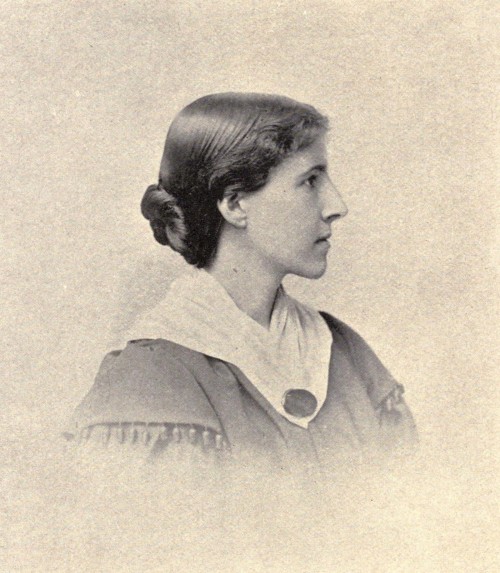 Taken a few years after the publication of “The Yellow Wallpaper,” this portrait photograph shows activist Charlotte Perkins Gilman’s feminine poise and respectability even as she sought massive change for women’s place in society. An outspoken supporter of women’s rights, Gilman’s works challenged the supposedly “natural” inferiority of women. Wikimedia.
Taken a few years after the publication of “The Yellow Wallpaper,” this portrait photograph shows activist Charlotte Perkins Gilman’s feminine poise and respectability even as she sought massive change for women’s place in society. An outspoken supporter of women’s rights, Gilman’s works challenged the supposedly “natural” inferiority of women. Wikimedia.
¶ 53 Leave a comment on paragraph 53 1 Women vocalized new discontents through literature. Charlotte Perkins Gilman’s short story “The Yellow Wallpaper” attacked the “naturalness” of feminine domesticity and critiqued Victorian psychological remedies administered to women, such as the “rest cure.” Kate Chopin’s The Awakening, set in the American South, likewise criticized the domestic and familial role ascribed to women by society and gave expression to feelings of malaise, desperation, and desire. Such literature directly challenged the status quo of the Victorian era’s constructions of femininity and feminine virtue, as well as established feminine roles.
¶ 54 Leave a comment on paragraph 54 1 While many men worried about female activism, they worried too about their own masculinity. To anxious observers, industrial capitalism was withering American manhood. Rather than working on farms and in factories, where young men formed physical muscle and spiritual grit, new generations of workers labored behind desks, wore white collars, and, in the words of Supreme Court Justice Oliver Wendell Holmes, appeared “black-coated, stiff-jointed, soft-muscled, [and] paste-complexioned.” ((Michael S. Kimmel, Manhood in America: A Cultural History (New York: Oxford University Press, 2006), 41.)) Neurologist George Beard even coined a medical term, neurasthenia, for a new emasculated condition that was marked by depression, indigestion, hypochondria, and extreme nervousness. The philosopher William James called it “Americanitis.” Academics increasingly warned that America had become a nation of emasculated men.
¶ 55 Leave a comment on paragraph 55 2 Churches too worried about feminization. Women had always comprised a clear majority of church memberships in the United States, but now the theologian Washington Gladden said, “A preponderance of female influence in the Church or anywhere else in society is unnatural and injurious.” Many feared that the feminized church had feminized Christ himself. Rather than a rough-hewn carpenter, Jesus had been made “mushy” and “sweetly effeminate,” in the words of Walter Rauschenbusch. Advocates of a so-called muscular Christianity sought to stiffen young men’s backbones by putting them back in touch with their primal manliness. Pulling from contemporary developmental theory, they believed that young men ought to evolve as civilization evolved, advancing from primitive nature-dwelling to modern industrial enlightenment. To facilitate “primitive” encounters with nature, muscular Christians founded summer camps and outdoor boys’ clubs like the Woodcraft Indians, the Sons of Daniel Boone, and the Boy Brigades—all precursors of the Boy Scouts. Other champions of muscular Christianity, such as the newly formed Young Men’s Christian Association, built gymnasiums, often attached to churches, where youths could strengthen their bodies as well as their spirits. It was a Young Men’s Christian Association (YMCA) leader who coined the term bodybuilding, and others invented the sports of basketball and volleyball. ((Norman Vance, The Sinews of the Spirit: The Ideal of Christian Manliness in Victorian Literature and Religious Thought (New York: Cambridge University Press, 1985).))
¶ 56 Leave a comment on paragraph 56 2 Muscular Christianity, though, was about even more than building strong bodies and minds. Many advocates also ardently championed Western imperialism, cheering on attempts to civilize non-Western peoples. Gilded Age men were encouraged to embrace a particular vision of masculinity connected intimately with the rising tides of nationalism, militarism, and imperialism. Contemporary ideals of American masculinity at the turn of the century developed in concert with the United States’ imperial and militaristic endeavors in the West and abroad. During the Spanish-American War in 1898, Teddy Roosevelt and his Rough Riders embodied the idealized image of the tall, strong, virile, and fit American man that simultaneously epitomized the ideals of power that informed the United States’ imperial agenda. Roosevelt and others like him believed a reinvigorated masculinity would preserve the American race’s superiority against foreign foes and the effeminizing effects of overcivilization.
¶ 57
Leave a comment on paragraph 57 1
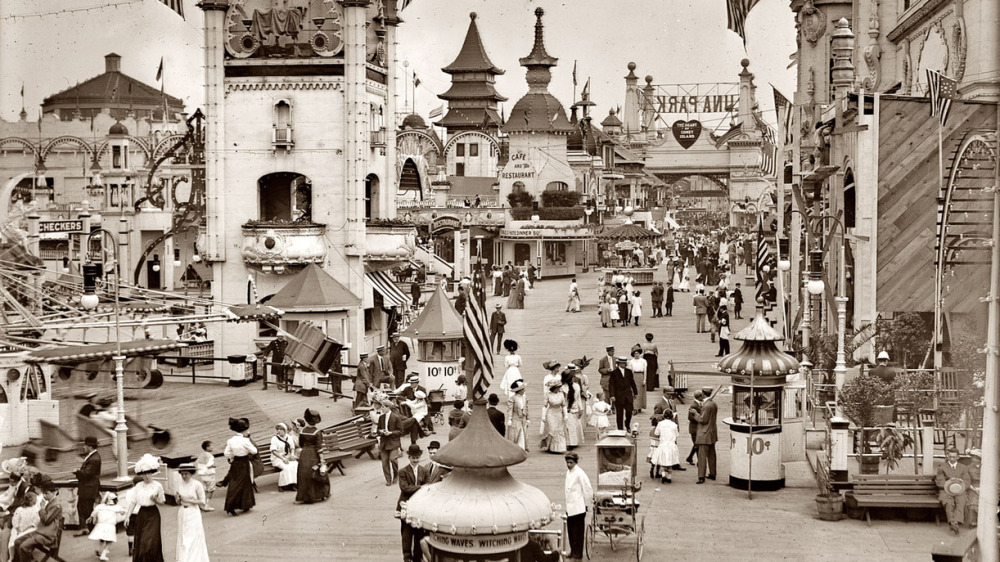 Amusement-hungry Americans flocked to new entertainments at the turn of the twentieth century. In this early-twentieth century photograph, visitors enjoy Luna Park, one of the original amusement parks on Brooklyn’s famous Coney Island. Visitors to Coney Island’s Luna Park, ca.1910-1915. Library of Congress (LC-B2- 2240-13).
Amusement-hungry Americans flocked to new entertainments at the turn of the twentieth century. In this early-twentieth century photograph, visitors enjoy Luna Park, one of the original amusement parks on Brooklyn’s famous Coney Island. Visitors to Coney Island’s Luna Park, ca.1910-1915. Library of Congress (LC-B2- 2240-13).
¶ 58 Leave a comment on paragraph 58 1 But while many fretted about traditional American life, others lost themselves in new forms of mass culture. Vaudeville signaled new cultural worlds. A unique variety of popular entertainments, these traveling circuit shows first appeared during the Civil War and peaked between 1880 and 1920. Vaudeville shows featured comedians, musicians, actors, jugglers, and other talents that could captivate an audience. Unlike earlier rowdy acts meant for a male audience that included alcohol, vaudeville was considered family-friendly, “polite” entertainment, though the acts involved offensive ethnic and racial caricatures of African Americans and recent immigrants. Vaudeville performances were often small and quirky, though venues such as the renowned Palace Theatre in New York City signaled true stardom for many performers. Popular entertainers such as silent film star Charlie Chaplin and magician Harry Houdini made names for themselves on the vaudeville circuit. But if live entertainment still captivated audiences, others looked to entirely new technologies.
¶ 59 Leave a comment on paragraph 59 4 By the turn of the century, two technologies pioneered by Edison—the phonograph and motion pictures—stood ready to revolutionize leisure and help create the mass entertainment culture of the twentieth century. The phonograph was the first reliable device capable of recording and reproducing sound. But it was more than that. The phonograph could create multiple copies of recordings, sparking a great expansion of the market for popular music. Although the phonograph was a technical success, Edison at first had trouble developing commercial applications for it. He thought it might be used for dictation, recording audio letters, preserving speeches and dying words of great men, producing talking clocks, or teaching elocution. He did not anticipate that its greatest use would be in the field of mass entertainment, but Edison’s sales agents soon reported that many phonographs were being used for just that, especially in so-called phonograph parlors, where customers could pay a nickel to hear a piece of music. By the turn of the century, Americans were purchasing phonographs for home use. Entertainment became the phonograph’s major market.
¶ 60 Leave a comment on paragraph 60 2 Inspired by the success of the phonograph as an entertainment device, Edison decided in 1888 to develop “an instrument which does for the Eye what the phonograph does for the Ear.” In 1888, he patented the concept of motion pictures. In 1889, he innovated the rolling of film. By 1891, he was exhibiting a motion-picture camera (a kinetograph) and a viewer (a kinetoscope). By 1894, the Edison Company had produced about seventy-five films suitable for sale and viewing. They could be viewed through a small eyepiece in an arcade or parlor. They were short, typically about three minutes long. Many of the early films depicted athletic feats and competitions. One 1894 film, for example, showed a six-round boxing match. The catalog description gave a sense of the appeal it had for male viewers: “Full of hard fighting, clever hits, punches, leads, dodges, body blows and some slugging.” Other early kinetoscope subjects included Indian dances, nature and outdoor scenes, re-creations of historical events, and humorous skits. By 1896, the Edison Vitascope could project film, shifting audiences away from arcades and pulling them into theaters. Edison’s film catalog meanwhile grew in sophistication. He sent filmmakers to distant and exotic locales like Japan and China. Long-form fictional films created a demand for “movie stars,” such as the glamorous Mary Pickford, the swashbuckling Douglas Fairbanks, the acrobatic comedian Buster Keaton, who began to appear in the popular imagination beginning around 1910. Alongside professional boxing and baseball, the film industry was creating the modern culture of celebrity that would characterize twentieth-century mass entertainment. ((Hochfelder, “Edison and the Age of Invention,” 499–517.))
¶ 61 Leave a comment on paragraph 61 1
VI. Conclusion
¶ 62
Leave a comment on paragraph 62 0
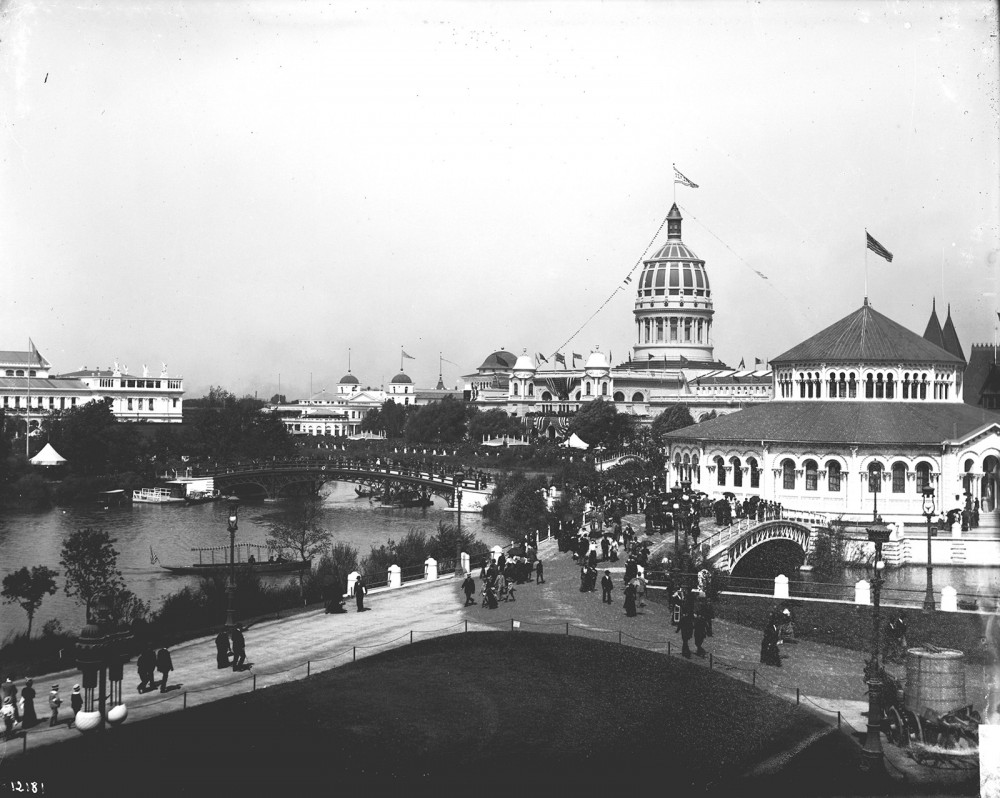 Designers of the 1893 Columbian Exposition in Chicago built the White City in a neoclassical architectural style. The integrated design of buildings, walkways, and landscapes propelled the burgeoning City Beautiful movement. The Fair itself was a huge success, bringing more than twenty-seven million people to Chicago and helping to establish the ideology of American exceptionalism. Wikimedia.
Designers of the 1893 Columbian Exposition in Chicago built the White City in a neoclassical architectural style. The integrated design of buildings, walkways, and landscapes propelled the burgeoning City Beautiful movement. The Fair itself was a huge success, bringing more than twenty-seven million people to Chicago and helping to establish the ideology of American exceptionalism. Wikimedia.
¶ 63 Leave a comment on paragraph 63 1 After enduring four bloody years of warfare and a strained, decade-long effort to reconstruct the defeated South, the United States abandoned itself to industrial development. Businesses expanded in scale and scope. The nature of labor shifted. A middle class rose. Wealth concentrated. Immigrants crowded into the cities, which grew upward and outward. The Jim Crow South stripped away the vestiges of Reconstruction, and New South boosters papered over the scars. Industrialists hunted profits. Evangelists appealed to people’s morals. Consumers lost themselves in new goods and new technologies. Women emerging into new urban spaces embraced new social possibilities. In all of its many facets, by the turn of the twentieth century, the United States had been radically transformed. And the transformations continued to ripple outward into the West and overseas, and inward into radical protest and progressive reforms. For Americans at the twilight of the nineteenth century and the dawn of the twentieth, a bold new world loomed.
¶ 64 Leave a comment on paragraph 64 0
VII. Primary Sources
¶ 65 Leave a comment on paragraph 65 0 Andrew Carnegie on “The Triumph of America” (1885)
Steel magnate Andrew Carnegie celebrated and explored American economic progress in this 1885 article, later reprinted in his 1886 book, Triumphant Democracy.
¶ 67 Leave a comment on paragraph 67 0 Henry Grady on the New South (1886)
Atlanta newspaperman and apostle of the “New South,” Henry Grady, won national recognition for his December 21, 1886 speech to the New England Society in New York City.
¶ 69 Leave a comment on paragraph 69 0 Ida B. Wells-Barnett, “Lynch Law in America” (1900)
Ida B. Wells-Barnett, born a slave in Mississippi, was a pioneering activist and journalist. She did much to expose the epidemic of lynching in the United States and her writing and research exploded many of the justifications—particularly the rape of white women by black men—commonly offered to justify the practice.
¶ 71 Leave a comment on paragraph 71 0 Henry Adams, The Education of Henry Adams (1918)
Henry Adams, the great grandson of President John Adams, the grandson of President John Quincy Adams, the son of a major American diplomat, and an accomplished Harvard historian, writing in the third person, describes his experience at the Great Exposition in Paris in 1900 and writes of his encounter with “forces totally new.”
¶ 73 Leave a comment on paragraph 73 0 Charlotte Perkins Gilman, “Why I Wrote The Yellow Wallpaper” (1913)
Charlotte Perkins Gilman won much attention in 1892 for publishing “The Yellow Wallpaper,” a semi-autobiographical short story dealing with mental health and contemporary social expectations for women. In the following piece, Gilman reflected on writing and publishing the piece.
¶ 75 Leave a comment on paragraph 75 0 Jacob Riis, How the Other Half Lives (1890)
Jacob Riis, a Danish immigrant, combined photography and journalism into a powerful indictment of poverty in America. His 1890, How the Other Half Lives shocked Americans with its raw depictions of urban slums. Here, he describes poverty in New York.
VIII. Reference Material
¶ 78 Leave a comment on paragraph 78 0 This chapter was edited by David Hochfelder, with content contributions by Jacob Betz, David Hochfelder, Gerard Koeppel, Scott Libson, Kyle Livie, Paul Matzko, Isabella Morales, Andrew Robichaud, Kate Sohasky, Joseph Super, Susan Thomas, Kaylynn Washnock, and Kevin Young.
¶ 79 Leave a comment on paragraph 79 0 Recommended citation: Jacob Betz et al., “Life in Industrial America,” David Hochfelder, ed., in The American Yawp, eds. Joseph Locke and Ben Wright (Stanford, CA: Stanford University Press, 2018).
¶ 80 Leave a comment on paragraph 80 0
¶ 81 Leave a comment on paragraph 81 0 Recommended Reading
- ¶ 82 Leave a comment on paragraph 82 1
- Ayers, Edward. The Promise of the New South. New York: Oxford University Press, 1992.
- Beckert, Sven. Monied Metropolis: New York City and the Consolidation of the American Bourgeoisie, 1850–1896. Cambridge, UK: Cambridge University Press, 2001.
- Bederman, Gail. Manliness and Civilization: A Cultural History of Gender and Race in the United States, 1880–1917. Chicago: University of Chicago Press, 1995.
- Blight, David. Race and Reunion: The Civil War in American Memory. Cambridge, MA: Harvard University Press, 2001.
- Briggs, Laura. “The Race of Hysteria: ‘Overcivilization’ and the ‘Savage’ Woman in Late Nineteenth-Century Obstetrics and Gynecology.” American Quarterly 52 (June 2000). 246–273.
- Chauncey, George. Gay New York: Gender, Urban Culture, and the Making of the Gay Male World, 1890–1940. New York: Basic Books, 1995.
- Cole, Stephanie, and Natalie J. Ring, eds. The Folly of Jim Crow: Rethinking the Segregated South. College Station: Texas A&M University Press, 2012.
- Cott, Nancy. The Grounding of Modern Feminism. New Haven, CT: Yale University Press, 1987.
- Cronon, William. Nature’s Metropolis: Chicago and the Great West. New York: Norton, 1991.
- Edwards, Rebecca. New Spirits: Americans in the Gilded Age, 1865–1905. New York: Oxford University Press, 2005.
- Gilmore, Glenda Elizabeth. Gender and Jim Crow: Women and the Politics of White Supremacy in North Carolina, 1896–1920. Chapel Hill: University of North Carolina Press, 1996.
- Gutman, Herbert. Work, Culture and Society in Industrializing America: Essays in American Working-Class and Social History. New York: Knopf, 1976.
- Hale, Grace Elizabeth. Making Whiteness: The Culture of Segregation in the South, 1890–1940. New York: Pantheon Books, 1998.
- Hicks, Cheryl. Talk with You Like a Woman: African American Women, Justice, and Reform in New York, 1890–1935. Chapel Hill: University of North Carolina Press, 2010.
- Kasson, John F. Amusing the Million: Coney Island at the Turn of the Century. New York: Hill and Wang, 1978.
- Leach, William. Land of Desire: Merchants, Power, and the Rise of a New American Culture. New York: Random House, 1993.
- Lears, T. J. Jackson. No Place of Grace: Antimodernism and the Transformation of American Culture, 1880–1920. Chicago: University of Chicago Press, 1981.
- Odem, Mary. Delinquent Daughters: Protecting and Policing Adolescent Female Sexuality in the United States, 1885–1920. Chapel Hill: University of North Carolina Press, 1995.
- Peiss, Kathy. Cheap Amusements. Working Women and Leisure in Turn-of-the-Century New York. Philadelphia: Temple University Press, 1986.
- Peiss, Kathy. Hope in a Jar: The Making of America’s Beauty Culture. Philadelphia: University of Pennsylvania Press, 1999.
- Putney, Clifford. Manhood and Sports in Protestant America, 1880–1920. Cambridge, MA: Harvard University Press, 2001.
- Silber, Nina. The Romance of Reunion: Northerners and the South, 1865–1900. Chapel Hill: University of North Carolina Press, 1997.
- Strouse, Jean. Alice James: A Biography. New York: Houghton Mifflin, 1980.
- Trachtenberg, Alan. The Incorporation of America: Culture and Society in the Gilded Age. New York: Hill and Wang, 2007.
- Woodward, C. Vann. Origins of the New South, 1877–1913. Baton Rouge: LSU Press, 1951.
¶ 83 Leave a comment on paragraph 83 0
¶ 84 Leave a comment on paragraph 84 0 Notes
Comment awaiting moderation